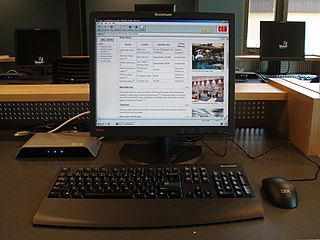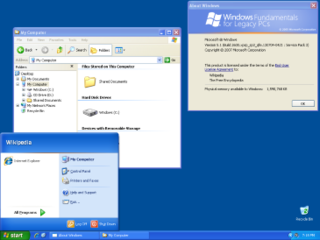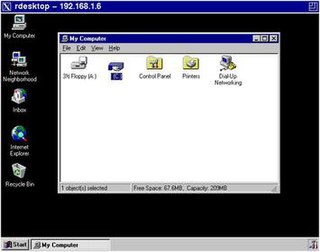
In computer networking, a thin client is a simple (low-performance) computer that has been optimized for establishing a remote connection with a server-based computing environment. The server does most of the work, which can include launching software programs, performing calculations, and storing data. This contrasts with a rich client or a conventional personal computer; the former is also intended for working in a client–server model but has significant local processing power, while the latter aims to perform its function mostly locally.

The X Window System is a windowing system for bitmap displays, common on Unix-like operating systems.
Independent Computing Architecture (ICA) is a proprietary protocol for an application server system, designed by Citrix Systems. The protocol lays down a specification for passing data between server and clients, but is not bound to any one platform. Citrix's ICA is an alternative to Microsoft's Remote Desktop Protocol (RDP).
Remote Desktop Protocol (RDP) is a proprietary protocol developed by Microsoft which provides a user with a graphical interface to connect to another computer over a network connection. The user employs RDP client software for this purpose, while the other computer must run RDP server software.
Linux Terminal Server Project (LTSP) is a free and open source terminal server for Linux that allows many people to simultaneously use the same computer. Applications run on the server with a terminal known as a thin client handling input and output. Generally, terminals are low-powered, lack a hard disk and are quieter and more reliable than desktop computers because they do not have any moving parts.

A diskless node is a workstation or personal computer without disk drives, which employs network booting to load its operating system from a server.
Windows Services for UNIX (SFU) is a discontinued software package produced by Microsoft which provided a Unix environment on Windows NT and some of its immediate successor operating-systems.
Remote administration refers to any method of controlling a computer from a remote location. Software that allows remote administration is becoming increasingly common and is often used when it is difficult or impractical to be physically near a system in order to use it. A remote location may refer to a computer in the next room or one on the other side of the world. It may also refer to both legal and illegal remote administration.

Windows Fundamentals for Legacy PCs ("WinFLP") is a thin client release of the Windows NT operating system developed by Microsoft and optimized for older, less powerful hardware. It was released on July 8, 2006, nearly two years after its Windows XP SP2 counterpart was released in August 2004, and is not marketed as a full-fledged general purpose operating system, although it is functionally able to perform most of the tasks generally associated with one. It includes only certain functionality for local workloads such as security, management, document viewing related tasks and the .NET Framework. It is designed to work as a client–server solution with RDP clients or other third party clients such as Citrix ICA. Windows Fundamentals for Legacy PCs reached end of support on April 8, 2014 along with most other Windows XP editions.

rdesktop is an implementation of a client software for Microsoft's proprietary Remote Desktop Protocol (RDP). Rdesktop is free and open-source software, subject to the requirements of the GNU General Public License (GPL-3.0-or-later), and is available for Linux and BSD as well as for Microsoft Windows.

DRBL is a NFS-/NIS server providing a diskless or systemless environment for client machines.
Oracle Secure Global Desktop (SGD) software provides secure access to both published applications and published desktops running on Microsoft Windows, Unix, mainframe and IBM i systems via a variety of clients ranging from fat PCs to thin clients such as Sun Rays.

In computing, the term remote desktop refers to a software- or operating system feature that allows a personal computer's desktop environment to be run remotely off of one system, while being displayed on a separate client device. Remote desktop applications have varying features. Some allow attaching to an existing user's session and "remote controlling", either displaying the remote control session or blanking the screen. Taking over a desktop remotely is a form of remote administration.
This page is a comparison of notable remote desktop software available for various platforms.
Adaptive Internet Protocol (AIP) is a multi-channel protocol that allows an application running on any of multiple platforms to be displayed on any of a wide range of client systems. It supports rich remote display and input services with a number of display options to deliver the presentation of the remote applications onto the local display either as a standalone window, or within a contained remote environment delivered full-screen or in a standalone window. The protocol also supports audio, printing, and other device mapping services.
Remote Desktop Services (RDS), known as Terminal Services in Windows Server 2008 and earlier, is one of the components of Microsoft Windows that allow a user to take control of a remote computer or virtual machine over a network connection. RDS is Microsoft's implementation of thin client architecture, where Windows software, and the entire desktop of the computer running RDS, are made accessible to any remote client machine that supports Remote Desktop Protocol (RDP). User interfaces are displayed from the server onto the client system and input from the client system is transmitted to the server - where software execution takes place. This is in contrast to application streaming systems, like Microsoft App-V, in which computer programs are streamed to the client on-demand and executed on the client machine.
Neatx is an open-source NX server based on NoMachine's NX technology. It is created by Google. Neatx is written mostly in Python, with the exception of very few wrapper scripts in bash and one program written in C. Neatx is free and open-source software, subject to the requirements of the GNU General Public License (GPL), version 2.
XenClient is a desktop virtualization solution from Citrix that runs secure virtual desktops on endpoint devices. Desktops are run locally, without hosting applications or the operating system in a datacenter. It consists of a Type-1 Xen client hypervisor and a management server, which provides features such as centralized provisioning, patching, updating, monitoring, policy controls, and de-provisioning. It enforces security through features including AES-256 full disk encryption, VM isolation, remote kill, lockout, USB filtering, and VLAN tagging. XenClient supports use cases such as disconnected operation on laptops, limited connectivity environments, and other use cases where use of local execution is desired and centralized management is required.

Wyse was an independent American manufacturer of cloud computing systems. As of 2012, Wyse is a subsidiary of Dell. Wyse are best remembered for their video terminal line introduced in the 1980s, which competed with the market-leading Digital. They also had a successful line of IBM PC compatible workstations in the mid-to-late 1980s. But starting late in the decade, Wyse were outcompeted by companies such as eventual parent Dell. Current products include thin client hardware and software as well as desktop virtualization solutions. Other products include cloud software-supporting desktop computers, laptops, and mobile devices. Dell Cloud Client Computing is partnered with IT vendors such as Citrix, IBM, Microsoft, and VMware.







